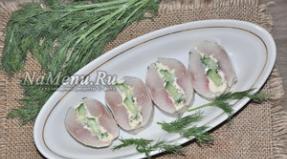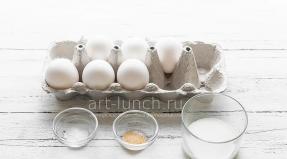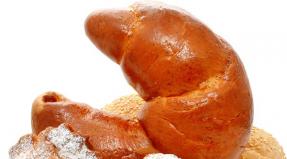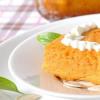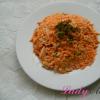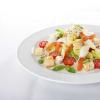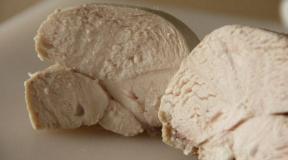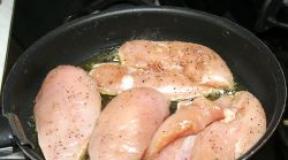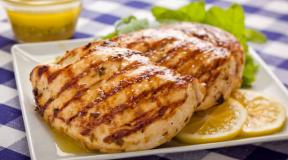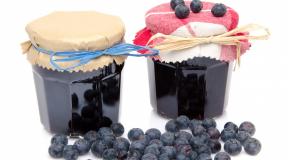Why is the yogurt in the yogurt maker sour. How to quickly make perfect yogurt in a yogurt maker
2649
3
Recipe for making homemade yogurt using a yogurt maker
Ingredients:
- 1 liter pasteurized milk, 3.5% fat
- 125 ml natural yoghurt
Cooking method: Combine yogurt and milk. Immediately after the components are combined, the mixture is distributed over the containers and placed inside the device, the yogurt maker is closed with a lid and plugged into the network. Typically, the fermentation process takes 6 to 10 hours, depending on the brand of machine and the end result. During operation, the yogurt maker must not be pushed, dropped or rearranged. After the expiration of the prescribed period, the glass (or glasses) is removed (they heat up slightly, and condensation forms on the lid of the apparatus), close the lids and place in the refrigerator. After an hour, the yogurt is ready to eat. Cooked yogurt can be used as a starter. Fruit puree, pieces of whole fruit, muesli, chocolate, etc. can be added to the finished yogurt to improve the taste.
Yogurt is called the gift of heaven. For the preparation of yogurt, a sourdough is used, consisting of pure cultures of thermophilic streptococcus and Bulgarian sticks (half and half). If this ratio is violated, the product may have a sharply sour taste, a granular structure, or quickly release whey. The starting product for yogurt is either milk or a mixture of milk and cream with a fat content of 6%. The mixture is pasteurized at 60–70 °C with a holding time of 30 minutes, and then cooled to 45 °C and sourdough is added in an amount of 2–3% (and 5% in curdled milk). Fermented milk is poured into a container (usually glass), where it is fermented. It must be borne in mind that with active leaven - and a temperature of 42-45 ° C for 2-3 hours, there is a rapid increase in acidity. To prevent the yogurt from becoming too sour, it is quickly cooled after active fermentation.
Properly prepared yogurt has a pleasant lactic acid taste and aroma, a uniform structure and a fairly dense texture.
Yogurt quickly relieves hunger and quenches thirst. Recommended for people of all ages, especially the elderly, as well as pregnant and lactating mothers.
Yogurt has become widespread in many countries of the world. By the way, this type of curdled milk is no different from the curdled milk produced under different names from buffalo and sheep's milk in Transcaucasia, where yogurt from these types of milk has been made since ancient times, although the origin of the sourdough is still unknown. This fermented milk product was considered by the locals as a gift from heaven. Yoghurt kept for a very long time, it got sourer and sourer, but it never spoiled. Caucasians kept dry yogurt in bags and used it as a starter. Sometimes dry yogurt was diluted with water and immediately drunk as a refreshing drink. The now extremely popular yogurt is also made from cow's milk, although cream and skimmed milk powder are added to it. In the Balkans, liquid yogurt is traditionally made and drunk as a drink. In other countries, it has the consistency of jelly or ice cream.
Yogurt can be used as a tenderizing marinade for meats and poultry, to thicken and enhance the flavor of casseroles, stews and some soups, and as a sauce for hot vegetable dishes. Natural yogurt containing beneficial bacteria (acidophilus and bifidobacteria) improves the functioning of the digestive system, making up for the lack of natural bacteria in the body.
Recipe for making homemade thick creamy yogurt without using a yogurt maker:
Combine 2 3/4 cups milk with 1/3 cup whole milk powder in a saucepan, heat gradually until boiling and frothy. Reduce heat and simmer gently over low heat for 20 minutes. Remove from heat and cool to 45 degrees. Skim and remove the foam from the milk, then carefully add 1/3 cup of natural yogurt mixed with 1/4 cup of milk, stir. Pour the mixture into sterilized jars and close. Put the jars in a saucepan and fill it with hot water from the tap. Wrap the pan in a blanket and keep warm for at least 6 hours. Refrigerate the yoghurt for 3-4 hours before use. Yogurt can be stored in the refrigerator for up to a week. Makes 2 cups.
As a rule, these mechanisms make it possible to create a homogeneous mixture rich in beneficial microorganisms in the shortest possible time. By maintaining the set temperature inside the device, the dairy product is uniformly fermented. At the same time, beneficial strains of bacteria present in the sourdough begin to multiply intensively.
Remember, the optimal temperature for fermenting yogurt is 37 - 42°C, and its holding period is 6-8 hours. After reaching the set parameters, the yogurt maker automatically switches to the mode of maintaining the set characteristics.
Choice of base for yogurt
The quality of the fermented drink directly depends on the type of milk chosen. Therefore, before buying a base for yogurt, you should determine in advance the desired consistency of the final product.
Varieties of milk
Pasteurized or UHT. A distinctive feature of these products is the absence of the need for their pre-boiling.
The consistency of the prepared mixture will directly depend on the degree of fat content of the selected milk.
If a non-fat yoghurt base (2.5 - 3%) is used, the fermented product will have a liquid structure and a slightly sour taste. To obtain a dense mixture with a neutral taste, it is necessary to use milk, the fat content of which is at least 6%.
sterilized. As a rule, this product has a long shelf life and a specific taste. However, in the process of its use, it is worth considering the possibility of the presence of non-natural components in the composition of milk.
homemade. If, as a basis for yogurt, whole cow's milk is chosen, then it is important to remember that the product is presented for sale without special processing.
That is why such raw materials must be boiled before ripening. After that, it must be cooled to a temperature of 37-42°C.
Yogurt made from homemade milk often has a firm texture and a creamy taste.
Ghee. As a rule, this product is used to make ryazhenka, as well as yogurt with a “special” taste. At the same time, for fermentation of baked milk there is no need for its heat treatment.
In addition, homemade cream can act as the basis for yogurt.
Thanks to this component, yogurt acquires a dense texture and creamy taste. To prepare such a dessert, combine milk and cream in the desired proportion, after which they are intensively mixed.
Making yogurt in a yogurt maker
Compliance with the technological sequence of preparing yogurt allows you to get a high-quality healthy product with a dense structure and a neutral taste..
Algorithm for making yogurt
boil milk. This procedure allows you to destroy pathogenic microorganisms, if any.
The duration of boiling milk should be at least three minutes.
After that, the resulting mixture should be cooled to 40°C.
Remember, the high temperature of milk (more than 44 degrees) has a detrimental effect on the state of beneficial bacteria.
Remove foam from the surface of milk. This action should be performed using a pre-sterilized spoon.
Prepare starter. This concentrate is produced in the form of powders, tablets or suspensions. As a rule, it contains live or freeze-dried strains of microorganisms.
To prepare the mother starter, combine the bacteria concentrate with a small amount of milk. Due to this, in the thickness of the dairy product, there is a uniform distribution of clots of sourdough.
After that, the resulting mixture is poured into the rest of the milk and mixed. At the same time, the ratio of sourdough and base for yogurt must comply with the manufacturer's instructions.
Remember, to prepare a fresh portion of the product, you should use the fermented milk mixture of the previous fermentation.
The storage period of the mother sourdough is no more than two days.
Prepare the yogurt maker. Before preparing yogurt, you should pre-treat the device using special detergents. To do this, the container is washed under running water, and the containers are sterilized.
This procedure will minimize the risk of pathogenic bacteria getting into the fermented product.
Pouring milk into jars. At the same time, sterile containers should be filled with the mixture to the top, using a ladle. After that, open jars are placed in a yogurt maker and covered with a common body lid.
Set the yogurt maker timer.
The duration of preparation of yogurt depends, first of all, on the fat content of milk, as well as on the food preferences of a person. As a rule, the optimal ripening period for the product is 6-8 hours. At the same time, prolonged heating of yogurt often leads to the appearance of a sour taste.
The finished product should be removed from the yogurt maker and left, for 15 minutes, in the open air. Then the containers are covered with lids and placed in the refrigerator for 4 hours. Thanks to this, the yogurt will acquire additional density and the desired flavor.
Remember, a fermented milk product can be used as a starter culture no more than 5 times.
The reason for this is the degeneration of yogurt bacteria, as well as their gradual displacement by colonies of lactic acid microorganisms.
Using a yogurt maker allows you to get a high quality fermented milk product at home.
At the same time, various desserts, mousses and sauces can be prepared on the basis of yogurt. To do this, it is enough to add fruits, berries, syrups, nuts, dried fruits, jam, spices or herbs to the mixture.
Sugar should be added to yogurt immediately before eating. If the ingredient is poured into the mixture before fermentation, then beneficial microorganisms will process sucrose instead of lactose, as a result, yogurt may not work.
In addition, granulated sugar is poorly soluble in a chilled product. Therefore, it must first be dissolved in a small amount of water.
Before combining the starter culture with the yogurt base, it is necessary preheat milk product. As a rule, after placing the jars with the mixture in the yogurt maker, their temperature automatically rises to the set value.
The milk mixture with sourdough must be intensively mixed.
Fulfillment of this requirement will ensure uniform distribution of the bacterial concentrate throughout the volume of the product.
Ready curdled milk should refrigerate for at least three hours in order to complete the course of biochemical reactions in it.
To make high quality yoghurt, use fresh milk and sterile dishes. In this case, the whole product must first be boiled.
Fresh fruits, berries, nuts and dried fruits should only be added to yogurt. after final thickening.
At the same time, at the initial stage of fermentation, it is allowed to combine the milk mixture with canned fruits only.
As a rule, these ingredients do not affect the process of milk fermentation.
During the operation of the yogurt maker, you should eliminate the possibility of mechanical impact on the device R. To do this, it must be installed on a stable table away from the working area of the room.
After turning off the yogurt maker, gently lift the body cover of the device. At the same time, it is necessary to ensure that the formed drops of condensate do not fall into the yoghurt.
Almost every housewife can find a small supply of food, both in the refrigerator and in kitchen cabinets. This includes not only packages of cereals, sugar and tea, but also vegetables, convenience foods and, of course, dairy products. Who among us does not like to eat yogurt, and the desire may arise unexpectedly, so the hostesses have everything ready.
When everything is fresh, it's good. What to do if supplies start to go bad, such as yogurt. It is no longer possible to eat an expired one, but it’s a pity to throw it away, in this case it can be put into action, that is, to cook something. So that the stomach does not hurt from confinement, the ideal option is baking. Here are some recipes.
Expired yogurt pancakes
We combine two glasses of yogurt, two eggs, three tablespoons of sugar and a pinch of salt, beat in a blender, gradually add one and a half glasses of flour (you may need a little more). The dough will turn out thick, so pancakes may look more like the American version - pancakes. Pour a pinch of soda into the mixture for splendor and add three tablespoons of odorless vegetable oil.
We heat the pan with a spoonful of oil, pour a small amount of dough and fry on both sides, like ordinary pancakes. Serve with any topic, jam, honey or condensed milk.
Pancakes are made from the same dough, the dough is made a little thicker and laid out in hot (!) Oil in a pan with a spoon.
Chocolate muffin and expired yogurt
In a bowl, combine one and a half cups of yogurt, two cups of flour, three eggs, a glass of sugar, a spoonful of baking powder (if not, soda or a spoonful of lemon juice will do). We divide the finished dough into two parts, into one we introduce 2-3 tablespoons of cocoa (depending on the love of chocolate baking).
We cover the form with parchment, grease it with butter and spread it on a spoonful of one test, then another (you can use two to make it faster). When all the dough is used, send the form to the oven and bake for 30-40 minutes. Pour the finished cake with chocolate icing if you want or cut it lengthwise and soak it with cream or condensed milk / jam. We serve. Another name for this pie is Zebra.
Excellent cherry pie made from stale yogurt
In a deep bowl, we combine the components for a dough - a glass of expired yogurt, a glass of jam (any) in this case, cherry and a spoonful of soda. Let stand for 10-14 minutes, then add two eggs beaten with a fork, sugar to your taste (note that the jam is quite sweet), a glass of chopped nuts (again, optional) and flour. We add it so much that the dough resembles thick sour cream, mix everything thoroughly.
We cover the form with parchment, be sure to grease it with butter or margarine and pour out the dough. It takes about an hour, maybe a little more. Readiness is best checked with a wooden skewer or a toothpick.
When the cake has cooled down a bit, it can be poured with whipped cream or sour cream.
Expired yogurt - the basis of a delicious biscuit
We combine a glass of cocoa, half a spoonful of baking powder, 300 grams of flour, a whisper of salt and a spoonful of soda. Add sugar to them in the amount of a glass. Separately, with a mixer, bring a glass of yogurt, three eggs and half a glass of vegetable oil to homogeneity. Combine both mixtures, mix well. Pour the dough onto greased parchment in a form or on a sheet, send to the oven until completely baked. Check for readiness with a toothpick.
To make the biscuit even tastier, we prepare the cream. We boil one and a half glasses of milk (fresh) with 120 grams of sugar and a pinch of vanillin (you can even put a vanilla stick, the smell will be delicious). Beat another glass of fresh milk again with 4 tablespoons of flour and one egg. Carefully pour the finished mixture into boiling milk (it is on minimum heat) and boil until the mass thickens.
We cut off the finished and slightly cooled biscuit along the edges (so that there is an even shape of the cake), cut it along and grease it well with cream, cover the halves, grease the top. Biscuit trimmings can be chopped with a knife or hands and put on top of the cake, pouring cream again. We coat the sides and let it soak for 60 minutes. If you like fruits or berries, you can put them between the cakes, it will turn out even tastier and more original.
The optimum temperature for making yogurt is 38-42 o C (up to 45 o C). For a good result, it is desirable to maintain this temperature throughout the milk fermentation process. You should also pay attention to the fact that the temperature of milk when mixed with sourdough should be in the region of 38-45 ° C, but not higher, since already at t 50 ° C, yogurt bacteria die.
Yogurt turns sour, why?
The taste of yogurt depends on the following factors:
First - leaven. Various lactic microorganisms (including different strains of the same bacteria) included in the starter are able to ferment milk with the formation of different amounts of lactic acid, respectively, the taste of the final product depends on the starter used. Therefore, the taste of classic yoghurt, delicate, with moderate sourness, differs from the product "Narine", which usually turns out to be more sour.
Second - ripening time and temperature . The longer the ripening time, the more acidic the product (lactic acid accumulates gradually). Here it is necessary to make a reservation that the fermentation time largely depends on the temperature. Under optimal conditions, fermentation is faster and 6-8, and sometimes 4 hours is enough for yogurt. To ferment yogurt in a home yogurt maker, usually 8-10 hours are enough, if the temperature is falling, as, for example, in a thermos, then the fermentation process can be longer, and yogurt must be kept for 10-12 hours.
If you put the starter into cold milk and put the product in the yoghurt maker, then the fermentation time will increase, because, even before the active fermentation process, the milk in the yogurt maker will have to warm up. Another point, when using dry bacterial starters, the first batch of yogurt ("mother starter") can be prepared longer, since it takes time for the activation of lactic acid organisms after the state of anabiosis.
When yogurt is re-fermented, the composition of the starter is constantly changing. In practice, each subsequent batch will be sourer than the previous one. With the first or second re-fermentation, reducing the fermentation time can help, in the future, as soon as the taste of yogurt ceases to suit you, you need to take a fresh starter.
Does yogurt get "slippery"?
Once in an uncomfortable environment, too cold or too hot, or with sudden changes in temperature, the bacteria begin to "defend themselves". They produce mucous substances, polysaccharides. Thanks to these mucous substances, the consistency of yogurt becomes more viscous, even slimy. By themselves, these substances are safe, "slippery" yoghurts can be eaten. Although this is of course a matter of individual taste preferences.
You will most often encounter this "defensive" reaction when you are making yogurt directly from dried bacterial starters. Coming out of the lyophilized form (anabiosis), bacteria, apparently, are especially sensitive to the environment.
To combat viscosity, you should add the starter to milk heated to the fermentation temperature (if you have previously boiled the milk, wait patiently until it cools down, before mixing with the starter, stir the milk so that the entire volume has the same temperature).
Another precaution is to take the bag of starter out of the refrigerator in advance to avoid sudden temperature changes.
Another option is to prepare the so-called "mother sourdough" from the sourdough (a bag of sourdough on a standard yogurt cup of warm milk, ferment for 8-12 hours), and from it the main batch of yogurt. With this option, the slimy consistency is much less common.
Yogurt curdled, why?
It happens that yogurt curdles. There may be several reasons:
- Stale, sour milk. In a yogurt maker, yogurts ferment well, even if the milk is not preheated. But it happens that milk, even store-bought, with a normal shelf life, turns out to be of poor quality. If you try to boil such milk, it will curdle. Yoghurts from such "raw materials" also do not come out.
- Acids. If you are fermenting yoghurt with fresh fruit, the presence of fruit acids may cause the milk to curdle before the fermentation process is complete, and the yogurt will not turn out. Add fruit to ready-made yogurt.
Yogurt does not work, does not ferment?
Yogurt may not ferment for a number of reasons:
- Milk. If the milk contains antibiotics that inhibit the growth of bacteria, then the yogurt will not ferment. It turns out that sourdough is a kind of indicator of the quality of milk. If the yogurt doesn't work, try changing the dairy brand or choose a different brand. UHT milk gives the most stable result. For homemade sour milk, this is the safest raw material. It happens that village milk fails, of course, it is unpleasant, but it can also contain antibiotics, for example, if they are added to animal feed. Fresh milk - does not ferment. During the first few hours after milking, there are substances in the milk that inhibit the development of any microflora.
- Temperature. This reason is relevant mainly if you are preparing yogurt without a yogurt maker. If the thermos or other utensils you use do not keep warm, or the place where you put the yogurt to ferment is subject to drafts, the temperature of the yogurt drops quickly. Yogurt may not ferment.
- Hot milk. Yoghurt bacteria die already at a temperature of 50 ° C. If you previously boiled milk, but did not wait until it cools to the desired temperature (36-42 ° C), then when mixed with sourdough, most of the bacteria could die and, accordingly, yogurt will not ferment. If you are using a yogurt maker, run the fermentation cycle again, sometimes this helps.
- Time. Depending on the conditions (mainly keeping warm), the yogurt needs 6 to 12 hours. If too little time has passed, then the yogurt might not have had time to ferment.
- "Inanimate" sourdough. From the starter, in which there are no "live" bacteria, yogurt will not work. If you use industrial yogurt as a starter, pay attention to the packaging. A very long shelf life or information that the product has been pasteurized, that is, it has undergone heat treatment after preparation, indicates that there are probably no "live" bacteria in it.
If you use dry sourdough, then the expiration date and storage conditions are also important (usually sachets with sourdough should be stored at a temperature not exceeding 20 ° C).
How to calculate the fat content and calorie content of yogurt?
The fat content and calorie content of yogurt is calculated based on the products from which yogurt is made (For convenience of calculation, we will assume that 1 ml of milk / cream = 1 g of product).
For example, if you use 1 liter of 3.5% fat milk (calorie content 61 kcal per 100 ml or 610 kcal per 1 liter), dry sourdough (calorie value can be taken as 0) and nothing else, then the calorie content of your yogurt will be 61 kcal per 100 ml: 610(kcal)/1000(ml)*100(ml).
If you replace 200 ml of milk with 20% fat cream (calorie content 206 kcal per 100 ml), then the calorie content of your yogurt will be 90 kcal per 100 ml: (0.61 (kcal) * 800 (ml milk) + 2.06 (kcal) * 200 (ml cream)) / 1000 (ml mixture of milk with yogurt) * 100 (ml product).
The same principle applies to fat content. If you use milk with 3.5% fat content, that is, 100 ml of milk contains 3.5 g of fat, then the fat content of yogurt will be 3.5%.
If you replace 200 ml of milk with 20% cream, then the fat content of yogurt will be approximately 6.8%: (0.035 (g fat) * 800 (ml milk) + 0.2 (g fat) * 200 (ml cream)) /1000(ml milk and cream mixture)*100(ml product).
How to choose a yogurt maker?
Yoghurt makers are produced by both Western and domestic manufacturers. The price of the device largely depends on the brand and built-in bells and whistles, although in fact the essence of all models is the same, and most of them, if not all, are made in China, that is, they are made in China.
Hence the conclusion that buying the most expensive model does not make sense. When choosing a yogurt maker, you can focus on several factors:
- There are yogurt makers, which are a single container, usually designed for 1 liter. In my opinion, such yogurt makers are successfully replaced by a thermos. Yoghurt makers, completed with portioned jars, seem to me more practical.
- The presence of a timer is certainly a convenient feature, but in practice it is not at all mandatory. By itself, the sound signal only reminds you that the time you have chosen has ended. But if you did not hear the signal and did not put the yogurts in the refrigerator, then the fermentation process will continue even at room temperature. It is much more important that the yogurt maker has an automatic shutdown function, which makes the appliance safer and more energy-saving. Even better, if the yogurt maker works on the principle of a thermos, that is, it heats up from the mains for some time, and then automatically turns off, while the desired temperature is maintained for another 8-10 hours.
- Jars, which are completed with yogurt makers, are glass and plastic. Glass ones are more hygienic and can be sterilized. The plastic ones are practically unbreakable. Another convenience, although not mandatory, is the ability to set the date of manufacture on some covers. By the way, yoghurts can also be fermented in ordinary glass glasses or small wine glasses, the main thing is that they fit into the yogurt maker without breaking the tightness when closing the lid.
- Pay attention to the dimensions and stability of the model. During the fermentation process, it is very important that the yogurt maker is completely at rest, so the model must successfully fit into the place chosen for it.
- There are also models that allow, in addition to yoghurts, to cook in the appliance, for example, homemade cottage cheese, but such yogurt makers are somewhat more expensive. Separately, I want to note yogurt makers, with the ability to select the fermentation temperature - this is a very useful feature, especially if you are preparing not only classic yogurts (for which t of 42 degrees is great), but also kefir, acidophilic products, sour cream, symbilact, bifivit - for these for starter cultures, other temperature regimes (30, 36 °C) are optimal. This does not mean that these products will not ferment in your usual yogurt maker, just the temperature regime corresponding to these types of bacteria allows microorganisms to develop most correctly and intensively, which makes your products even tastier and healthier. To date, I know of only one such yogurt maker - VIVO ThermoMaster, designed specifically for VIVO bacterial starters. If you don’t have such a device in your arsenal - don’t be upset, you can use, for example, a thermos, preheating the milk to a lower temperature compared to yogurt.
Ask your question in the comments or blog social group theme.
There are three forms of homemade yogurt: liquid, pasty...and in balls :)
In a previous article (see link above), I talked a little about the properties of yogurt and what dishes can be prepared from it. It turned out that not everyone knows what expressed yogurt is, how it is obtained and how it can be used. I'll tell you in order :)
In the title photo - homemade yogurt. Now, however, we rarely cook it, so we only have an old photo at hand. Yogurt (or rather, a product that looks like it) is easy to cook at home: the main thing is to find a suitable starter.
In different regions, a similar product is called differently (yogurt, katyk, matsun, dahi, matsoni, etc.), it is prepared from different milk, in different climatic and even domestic conditions, different starter cultures are also used, plus, as always - human factor. That is why I do not participate in disputes on the topic “whose “Bulgarian stick” is more correct: Bulgarian, Greek, Turkish, Indian or Armenian” and, accordingly, “whose yogurt is better and tastier” and “what product can be called yogurt”.
If you manage to cook homemade yogurt on dry sourdough from a pharmacy or on "white" yogurt from a store - cook :) I have been noticing for a long time that if they are going to work with homemade yogurt, decant it, then even in oriental cuisines (including in cafes and restaurants), almost any suitable fermented milk product, even sour cream, is taken as a starter for making yogurt itself. It's not in my plans to discuss this either :)
The only thing I don't really like is that nowadays it is fashionable to cook yogurt with the help of electrical appliances, however, you can get an instant product with incomprehensible properties in them.
The fact is that yogurt should ferment slowly and on its own for 8-12 hours (maybe less in summer), and some manufacturers of yogurt makers, etc. appliances boast that their "yogurt" is obtained in 3-4 hours (maximum 6), and even milk does not have to be boiled for this. Many culinary specialists prepare a kind of "drinking yogurt" in just such a time (4 hours), and "to make it thicker, you need to set it for 7-8 hours." It comes to the fact that milk and sourdough are taken directly from the refrigerator and simply mixed with a mixer. Like, miracle technology will do everything on its own. And they also advise adding a filler (fruits, dried fruits, chocolate, etc.) right during fermentation. Maybe something tasty comes out, but I don’t think it’s necessary to call it yogurt or expect real benefits from it. In addition, very often come across reviews about the technical imperfection of such devices.
I am not against household appliances in the kitchen, but any of them needs to be dealt with individually, as well as with the quality and properties of the dishes that they produce. For example, take the same trendy smoothie drink, similar to lassi, if it is prepared with yogurt, milk and various fruits: they threw everything into a blender, without understanding the properties of the products, it ground everything there ... and the person thinks that on the output turned out to be a complete benefit ...
Yogurt is a heavy product, all medical traditions speak about it. Under different names, it has been known for a long time in different world regions, its properties are well studied. It is no coincidence that there are recommendations to add spices, oil, honey to it or dilute it with water (and even depending on the constitution of a person - in different proportions).
Yogurt is not compatible with sour fruits, milk, melons, nuts (for more details, see the article on lassi). It is a good remedy for diarrhea, but is not used for constipation (it tends to cause them). Fresh yogurt has a sweet taste, and old yogurt, which has stood for more than 3 days after preparation, is sour, can rarely provide real help to the intestines, and most often causes these constipations.
Yogurt is a mucus-forming product, so it is not recommended for colds. Like all fermented milk products, it has warming properties, therefore, in summer, pure yogurt is usually not consumed, but diluted with water, getting the appropriate soups and drinks.
I am now talking about a product that can be called "real yogurt", and not about "3-hour drinking yogurt from a slow cooker", obtained in violation of the technologies.

This product is positioned as one of the best German yogurts. By the way, once, a very, very long time ago, the inhabitants of the Fatherland got acquainted with yogurt precisely through German products. Those who could travel abroad knew about Bulgarian and Turkish yogurt, and maybe even Greek. But personally, all my first memories are connected with German ones. So: there is nothing in this product for which one could pay such money as they ask for it :) Ingredients: yogurt, sugar, 13.5% apricot puree, flavoring. Fat content 3.1%. Naturally, those who for some reason cannot prepare yogurt at home are happy to buy it in the store. And who can - with the same pleasure cooks at home.
How to make yogurt at home
Take the milk you trust and bring it to a boil while stirring. If you need thick yogurt, milk can be reduced by ¼ or even 1/3. For these purposes, for example, starch and other thickeners are added to store-bought yogurt. These additives are also recommended by some manufacturers of yogurt makers. The question is: why then cook yogurt at home? :)
After boiling, the milk is cooled. The ideal temperature for fermenting yogurt is about 45 degrees (if the little finger, dipped in milk, calmly stays there for 10 seconds). Ideally, milk after boiling - before introducing the starter - should be poured into a clean, sterile container with a lid (for example, a saucepan).
The sourdough must be diluted with a portion of the same milk, stirred, added to the remaining milk and mixed well. After the introduction of the starter, close the pan tightly, wrap it (for example, with a blanket or even two) or put it in a warm place (30-45 degrees). It is advisable not to move the pan or shake it. You can immediately pour into several sterilized jars, if it is possible to wrap each one separately.
If dry sourdough is used, then follow the instructions that come with it. If, for example, liquid yogurt without additives is used instead of sourdough, then up to 100 g of sourdough is taken per 1 liter of milk. If you use strained yogurt (suzma) instead of sourdough, then from 1 tablespoon. If the milk is pre-boiled, then less starter may be needed. The exact proportions are always checked only in practice.
The pan should not stand warm for more than 12 hours! I heard this figure from the lips of residents of different regions. After 5-6 hours, you can carefully check whether the milk has curdled. Yogurt should be thick and dense. If the milk has not curdled, check it every hour. If the pan is in a very warm place, you need to make sure that the yogurt does not "ferment" (this will become noticeable by the release of whey).
Once cooked, yogurt is stored in a cold place to stop bacteria from growing. It will thicken even more as it cools.
"In Vedic cooking, yogurt is an indispensable staple, for in India, homemade yogurt and cheese are used almost as widely as vegetables, cereals and legumes. When it comes to dairy products, freshness cannot be underestimated: from the moment it is prepared, the aroma and nutritional value of dairy products decreases as quickly as greens removed from the garden.The fresher the yogurt or cheese you make, the more inspiring the cooking process will be.
The yogurt used for sourdough must be fresh and slightly sweet; if milk is fermented with old sour yogurt, then the resulting yogurt will also be sour.
Yogurt added to the dish serves as a binding medium and gives the dish a special texture and tenderness. It is used to prepare many dishes of Vedic cuisine, from the delicate lassi drink to the nutritious salads - rait. If you remove excess moisture from yogurt, you get a low-calorie dehin cheese, which, when sugar is added, turns into an exquisite Shrikhand dessert - a traditional dish of the state of Maharashtra. "(Yamuna Devi" Lord Krishna "s Cuisine: The Art of Indian Vegetarian Cooking"; Yamuna Devi's "Favorites of Indian Vegetarian Cuisine").
Vegetarians who look up to Indian cuisine know what shrikhand. I also once cooked it, this dessert turned out well for me at one time even from Activia, not to mention homemade yogurt.
My old-old photo: shrikhand (strained fresh yogurt whipped with rose water and honey).

These desserts are very easy to prepare with strained yogurt and are always loved by children.
